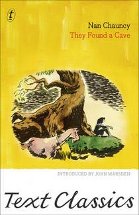They found a cave by Nan Chauncy

Text Publishing, 2013. ISBN 9781922147196.
Originally published in 1948, this story involves four English
children who are sent to live with their Aunt on a farm in the
Tasmanian wilderness, to remove them from the danger of the Second
World War. Cherry and her brothers Nigel, Brickenden and little
Nippy work around the farm and befriend the brave and resourceful
Tas, the son of Mrs. Pinner who is employed by their Aunt Jandie.
When Jandie leaves the farm for medical treatment over an extended
period, Mrs Pinner and her partner are left in charge and soon
commence to mistreat the children. The children decide to run away
and do so with the help and guidance of Tas who jumps at the chance
to escape his mother and step father.
Knowing the bush intimately, Tas leads the group, accompanied by a
herd of goats to a secret cave on a mountain plateau where they live
a rough but exhilarating existence ungoverned by adults.
The story is a little implausible given that the children thrive for
several months in the harsh Tasmanian climate sustained by the
goats, living off the land and the booty from occasional raids on
the farm. The story is pitched at primary level and junior readers
will enjoy envisaging themselves in this situation, surviving
independently and hiding out from adults. The conversational
language echoes Enid Blyton's and is so dated and twee that the
story is spoiled for contemporary readers. Gender roles are
similarly presented, with Cherry assigned all the cooking,
housekeeping and mothering of Nippy. Retro artwork on the book's
cover will not appeal to modern children.
I feel compelled to warn that the story contains language and
concepts which will cause cultural offence to some readers. The
problem with this content is that it is simply presented in a way
which is faithful to the era, in the sense that these views would
have been held and the terms used without consideration of their
impact. This differs markedly to fictional literature in which
characters having racist attitudes and using offensive terms are
depicted, yet these elements are usually presented in a way which
illustrates the folly of these views and the social harm caused,
before leading to a more constructive resolution.
John Marsden points to the author's great respect for Indigenous
Tasmanians in his introduction and the utterances of Chauncey's
child characters are more ignorant than they are deliberately
racist. Whilst acknowledging the reality of the era and that
revisionist or sanitised versions of history are false, it is
difficult to imagine all young readers for whom this is intended
being discerning enough to independently reconcile the attitudes and
language in the context of history. I recommend that teachers and
librarians read this novel carefully.
Rob Welsh